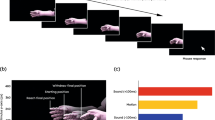Abstract
This study was aimed to characterize and investigate the feasibility of the electrically-elicited sensation as a sensory feedback technique. Two experiments were performed using a monophasic rectangular pulse train of which either the current or the frequency was modulated. The activation and pain thresholds, the discrimination ability and the description of the sensations were defined, measured and analyzed for ten healthy subjects. Diverse thresholds were acquired due to the individual differences in perceptual functioning, implying the technique should be intended for personalized systems. The discrimination ability was represented with a linear regression model providing the discrimination ability value that showed how much we have to change the parameter of interest in order to elicit a different sensation. 80% of the cases were well-represented by the linear regression models. The remaining 20% were better approximated by a curve, coinciding with the lowest discrimination ability values calculated for each experiment. The discrimination ability results provided an insight into the amount of information that can be transmitted to the body by our stimulation. The tactile sensations were reported as well-defined, describable and localizable. Our results supported the usability of electro-tactile stimulation as a non-invasive and easily-employable technique for the sensory feedback system.
Similar content being viewed by others
Abbreviations
- DAT:
-
Discrimination Ability Test
- AT:
-
Activation Threshold
- PT:
-
Pain Threshold
- CAT:
-
Current Activation Threshold
- FAT:
-
Frequency Activation Threshold
- CPT:
-
Current Pain Threshold
- FPT:
-
Frequency Pain Threshold
- CIMP:
-
Current Interval Middle Point
References
Biddiss, E., Beaton, D., and Chau, T., “Consumer design priorities for upper limb prosthetics,” Disabil. Rehabil. Assist. Technol., Vol. 2, No. 6, pp. 346–357, 2007.
Cipriani, C., Zaccone, F., Micera, S., and Chiara, M., “On the shared control of an EMG-controlled prosthetic hand: analysis of userprosthesis interaction,” IEEE Trans. Robotics, Vol. 24, No. 1, pp. 170–184, 2008.
Chouvardas, V., Miliou, A., and Hatalis, M., “Tactile displays: Overview and recent advances,” Displays, Vol. 29, No. 3, pp. 185–194, 2008.
Konyo, M., Tadokoro, S., Yoshida, A., and Saiwaki, N., “A tactile synthesis method using multiple frequency vibrations for representing virtual touch,” Proc. of IEEE/RSJ Int. Conf. on Int. Rob. Sys., pp. 3965–3971, 2005.
Marcus, P. and Fuglevand, A., “Perception of electrical and mechanical stimulation of the skin: implications for electrotactile feedback,” J. of Neural Eng., Vol. 6, No. 6, pp. 1–12, 2009.
Szeto, A. and Saunders, F., “Electrocutaneous stimulation for sensory communication in rehabilitation engineering,” IEEE Trans. Biomed. Eng., Vol. 29, No. 4, pp. 300–308, 1982.
Kajimoto, H., Kawakami, N., and Tachi, S., “Electro-tactile display with tactile primary color approach,” Proc. of IEEE/RSJ Int. Conf. on Int. Rob. Sys., 2004.
Sahin, M. and Tie, Y., “Non-rectangular waveforms for neural stimulation with practical electrodes,” J. of Neural Eng., Vol. 4, No. 3, pp. 227–233, 2007.
Field-Fote, E. C., Anderson, B., Robetson, V. J., and Sprelholz, N. I., “Monophasic and biphasic stimulation evoke different responses,” Muscle & Nerve, Vol. 28, No. 2, pp. 239–241, 2003.
Rubinstein, J. T., Miller, C. A., Mino, H., and Abbas, P. J., “Analysis of monophasic and biphasic electrical stimulation of nerve,” IEEE Trans. Biomed. Eng., Vol. 48, No. 10, pp. 1065–1070, 2001.
Grill, W. M. and Mortimer, J. T., “Stimulus waveforms for selective neural stimulation,” IEEE Engineering in Medicine and Biology Magazine, Vol. 14, No. 4, pp. 375–385, 1995.
Lundstrom, R. J., “Responses of mechanoreceptive afferent units in the glabrous skin of the human hand to vibration,” Scand. J. Work. Environ. Health, Vol. 12, No. 4, pp. 413–416, 1986.
Ara, J., Hwang, S. H., Song, T., and Khang, G., “Electrically-elicited tactile sensation for different modulation types, polarities and waveforms of stimulation pulse trains,” Int. J. Precis. Eng. Manuf., Vol. 13, No. 10, pp. 1911–1916, 2012.
Author information
Authors and Affiliations
Corresponding author
Rights and permissions
About this article
Cite this article
Cordon, S.M.G., Hwang, S.H., Song, T. et al. Current and frequency modulation for the characterization of electrically-elicited tactile sensations. Int. J. Precis. Eng. Manuf. 13, 2051–2058 (2012). https://doi.org/10.1007/s12541-012-0270-5
Received:
Accepted:
Published:
Issue Date:
DOI: https://doi.org/10.1007/s12541-012-0270-5




